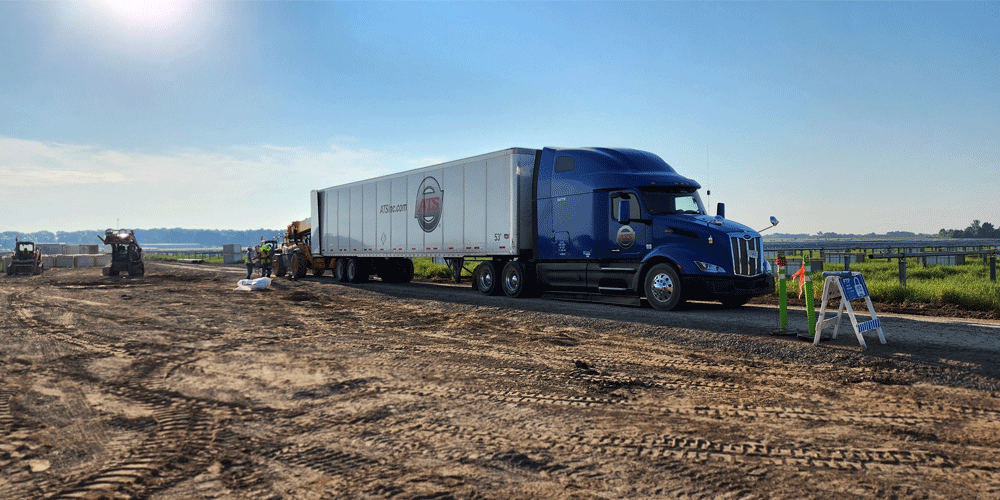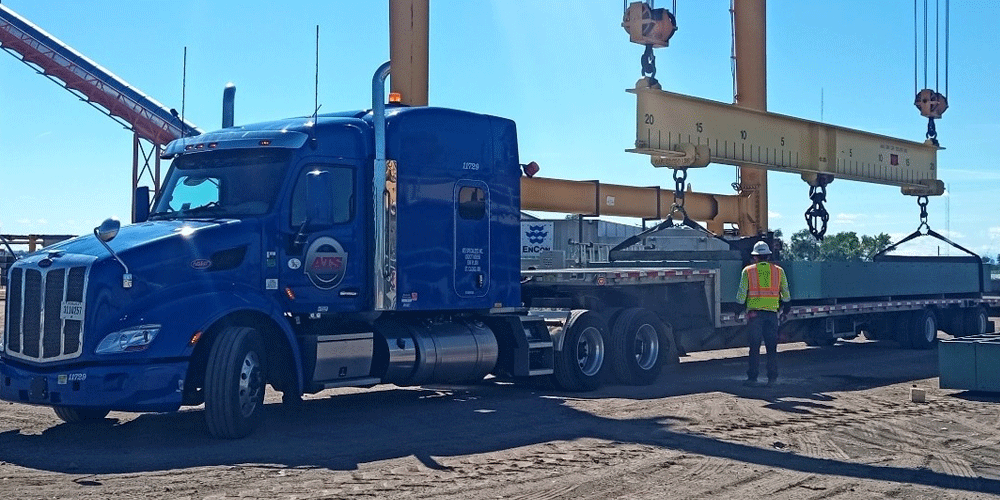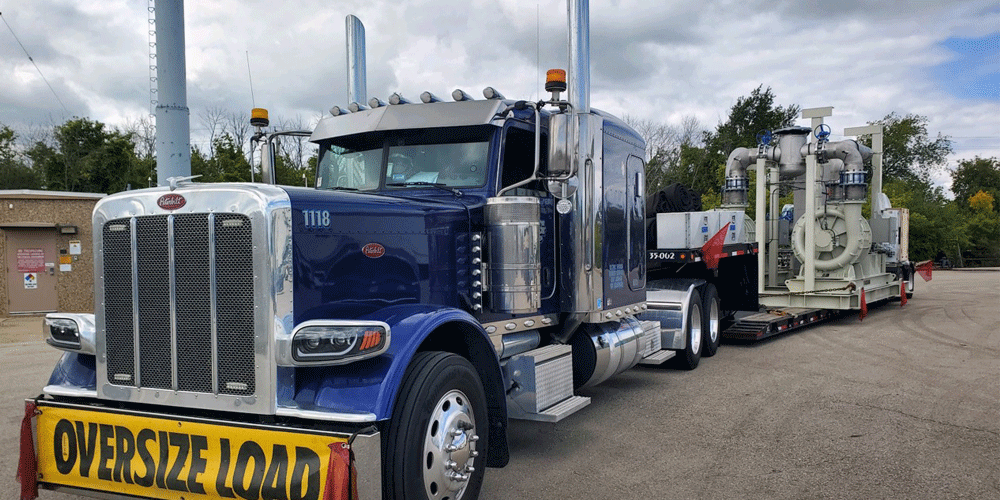Best Practices for Hauling Freight in a Soft Market: Turning Don’ts to Dos
Logan joined the ATS team in 2016. As a driver manager in the specialized flatbed division, he plays an important role in helping drivers achieve success and create happiness in their roles. He relishes in helping to plan a driver’s week and watching it turn into a nice paycheck to take home.
The trucking industry right now is a little different than it was just a year ago.
2022 has brought about a freight market where you have to change your running style to maintain an income you’re comfortable with.
Freight rates in the spot market are down overall and freight availability is also down. That means you might be running the same number of loads you always were but not making as much money. Or, you might be sitting around waiting on loads when you never had to before.
You may have adopted certain habits during the height of the pandemic when freight rates were through the roof. Some drivers could name their price and they always had a load to haul. Things have changed and those habits you became accustomed to may no longer work — and may even be boxing you in.
If you were picky about load selections before, you could count on another great-paying load offer. Now if you do the same thing, you could be waiting days for another load or you could be forced to take a lower-paying load.
It’s time to turn your don’ts into dos.
As a driver manager with a successful fleet of drivers at Anderson Trucking Service (ATS), I’m here to tell you some of the ways I’ve seen drivers box themselves in and ways I’ve seen them adapt to this freight market to excel.
In this article, you’ll learn about some of the behaviors that could be boxing you in and how you can turn it around.
Haul More Physically Intensive Loads
If you’re physically able to do so, taking on more physically intensive loads can help you earn a few extra bucks.
If you’re a flatbed driver, you may not like tarping loads, and you may have been able to avoid those loads in the past, but no longer.
No driver likes to tarp (kudos to you if you’re one of the very few that does). But if you continue to turn down those loads, you’re limiting yourself and you’re limiting your potential to haul some high-paying loads.
As a van driver, consider hauling high-touch freight. You could earn an extra $300 just by unloading one load.

Run In Areas You Don’t Like
Say hello to the Big Apple, Canada and the Northeast! Every driver has preferences of where they do and don’t want to run. But in a down market, and especially in the first quarter of the year, there aren’t as many freight options. You have to be willing to go where the money takes you.
Be willing to step out of your comfort zone. You may have to take loads where you typically don’t like to run, but doing so will increase your earning potential.
For example, a lot of drivers don’t like driving in cold weather, so they try to stick to the warmer states in the south when winter comes. They want to stay warm. Flatbed drivers don’t want to tarp and secure freight in the cold, which is understandable. However, when every driver has the same mindset, trucks flood the warmer areas. The overflow of drivers doesn’t help the freight situation. There are more trucks than loads to haul.
But, if you’re willing to do the things other drivers aren’t, that sets you apart. When other drivers are crowding the south, you have a lot more freight options in other areas because you’re willing to work in the cold.
This might mean you have to drive through some heavy traffic areas which, again, isn’t always fun. It can be stressful and intimidating. The best way to prepare is to trip plan as best as you can. When you trip plan, you won’t be surprised by anything when you arrive at your destination.
Look at a satellite view of your location to determine the safest way to get in and out. Call the shipper/receiver for specific directions.
If you can, plan your drive time so you won’t be traveling through major cities during rush hour. You can’t always accommodate that when you have to deliver at a certain time, but if you can start your day early or drive overnight, try it.
Get Endorsements and your TWIC Card
Now is the time to increase the type of freight you can haul. If you don’t have endorsements, it’s a good idea to get them now. You’ll open up your freight opportunities. You can earn the HazMat endorsement (H), doubles and triples endorsement (T), tanker endorsement (N) and tanker/HazMat endorsement (X).
Earning your Transportation Worker Identification Credential (TWIC®) is a big deal, especially during a soft market when freight slows down. A TWIC Card is a requirement of the Maritime Transportation Security Act for drivers who want to access secure areas at maritime facilities and vessels.
Some ports accept escorts if you don’t have a TWIC Card, but that escort service can have a high financial cost. However, chances are your company won’t offer you loads at ports if you don’t have a TWIC; they’ll give those loads to other drivers.
Drivers need to go through a security threat assessment background check to ensure eligibility. You can either complete the online application or fill it out at an application center. Schedule an appointment at a TWIC application center to provide documentation, provide a photo and get your fingerprints taken. You’ll also have to pay a fee for the card. Once approved, the card will be mailed to you.
Now might also be the time you decide to pursue your Transportation Security Administration (TSA) certification so you can haul cargo from an airport or pursue clearance from the Department of Defense (DOD) to haul military freight.
Pull a Variety of Trailers
Everyone has a different comfort level regarding what they will and will not haul, but if you’re comfortable hauling larger and larger loads, you’ll give yourself more options.
Don’t marry yourself to a trailer. For instance, I know some drivers that only want to haul certain trailer types, like a removable gooseneck trailer (RGN). The RGN is a popular trailer for ATS drivers. You can haul larger freight on it, it can help you move up in over-dimensional freight classes and it sits lower to the ground so it can be easier to secure loads on it.
Van drivers shouldn’t just haul dry vans. As long as you have proper endorsements, consider hauling doubles and triples, reefers or tankers. You could make more money in the area you’re running by switching trailer types. If you want to boost your income, be willing to make the switch.
If you stick to one trailer and one trailer only, you’re not operating your business optimally. You might think you can only make money hauling one particular trailer, but it’s not true.
Dig deep and think about whether you’re only hauling one type of trailer because it’s easier (less securement, no tarping, etc.) or if it’s the best business decision.
Related: How to Become an Oversize Load Driver
Travel to All the Lower 48 States
This, again, comes back to opening up your availability.
I’ve worked with drivers who refuse to travel to the western part of the country. They’ll say, “I’m not traveling west of this area” and they have certain reasons for it. Maybe they don’t like driving through the mountains or they’re worried about the freight rates coming out of the area.
Despite drivers’ concerns about running in the western part of the country, I would never — even in a good market — recommend that drivers put a limitation on moving freight in certain areas.
You have to be smart about which loads you’re taking. Make sure the freight rate going in is worth it and that you have a load coming out of the area. Talk to your driver manager to ensure taking a load in that area will be profitable. They’re going to be honest with you and make sure you’re making the best decision for your business.
Related: How to Navigate Headhaul and Backhaul Freight Markets
Save Up for Home Time
When the market was hot and freight rates were through the roof, drivers could easily afford to go home whenever they wanted. The tables have turned in this market. To maximize your income, you must be mindful of how much home time you take and when.
You may not get to go home every weekend or for every little thing you want to be home for if you want to remain profitable. And when you do plan to go home, you’ll need to be mindful about ensuring you’ve put money aside to cover all your expenses.
Don’t Fixate on Per-Mile Rates
A lot of independent contractors tend to fixate on per-mile rates. While you certainly have to look at what a load pays per mile, it shouldn’t be the only thing you review. A load offer with a high per-mile rate isn’t always the determinant of the best load offer. You also have to consider miles.
For example, let’s say you have a load offer that pays $1.80 per mile and one pays $2.00 per mile. Without knowing anything else about the load offer, the $2.00 per-mile load sounds like the better choice right? Of course it does.
But how many miles is each load?
The load paying $2.00 per mile might only be 200 miles, which will only earn you $400. The $1.80 per-mile load might be 500 miles and you’ll earn $900. If you sit around waiting for a load that pays $2.00 per mile and higher, you might be waiting days and have nothing to show.
Let’s talk through another example. Let’s say the load paying $2.00 per mile is 1,500 miles and the load paying $1.80 is 600 miles.
You get empty on Wednesday morning and the 1,500-mile load that pays $2.00 per mile loads on Thursday for a Monday delivery. If you take the 1,500-mile load, you tie up one day just waiting for the load. If it takes you until Monday to deliver, you’re on the load for six days total. You earn $3,000 or $500 per day.
The 600-mile load paying $1.80 per mile loads on Wednesday and can deliver Thursday or Friday. It pays $1,080. If it takes you two days to deliver, you average $540 per day. You may be able to pick up and deliver one or two more loads before the weekend is over — giving you two more loads on your paycheck. You could make another $2,160 or more.
Not only did the cheaper per-mile rate load earn you more money on your paycheck next week, but it also earned you more money per day.
The point is: As an independent contractor, don’t only focus on the per-mile rate. Think about when loads need to deliver and how long it’ll take you to deliver the loads. Put higher importance on how much money the load will make you per day versus what the per-mile rate is.
Don’t Box Yourself In
It can be tough to break your bad habits on the road, but working on one habit at a time can significantly increase your load options. And that’s what this is about: increasing your opportunities.
In a market where freight is less available and loads aren’t paying as much as they used to, you can’t afford to be choosy. Waiting for the perfect load can mean the difference between a paycheck or no paycheck.
Being successful on the road ultimately comes down to determining your operating costs, operating efficiently to move more loads and understanding the market.
Contracting with a stable, well-established company can also be beneficial to you. At ATS, we have a wide array of customer freight and a large logistics department to ensure we always keep you moving.



